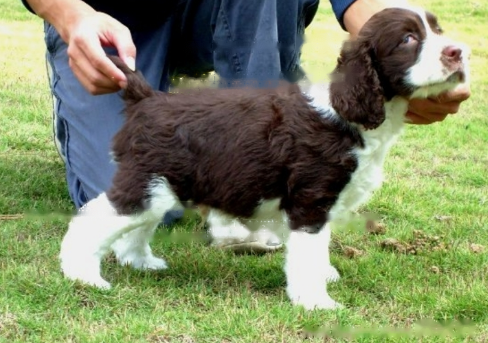The English Springer is a medium-sized sporting dog with a compact body and a docked tail. The coat is of moderate length, with feathering on the legs, ears, chest, and belly. His drooping ears, gentle and refined expression, firm structure and friendly wagging tail declare him unquestionably a member of the old family of snipe dogs.

1. Topline of neck and torso
Neck moderately long, strong, neat, slightly arched on high head, continuous with sloping shoulders connect smoothly. This part of the topline from shoulder to tail is firm and slightly sloping. The trunk is strong and compact, with short ribs and joints. The chest is deep and level with the elbows, the forechest well developed; but not hindering the movement of the front legs. Ribs are long, extending continuously to the middle of the torso, tapering as they reach the end of the rib. The lower line is level with the elbows and there is a slight upward bend in the side of the abdomen. The back is straight, strong and level. The loin is short, strong and slightly arched. The rump is elegantly rounded and joins smoothly with the hind legs. The rump is gently sloping towards the base of the tail, which hangs naturally along the rump. The tail is level or slightly raised, showing its lively personality and happy action in the hunt. A tightly clipped tail, suggesting a timid and unreliable temperament would be a disadvantage, and like a hard dog, the tail forms a suitable angle with the topline.
2. Forequarters
The efficient movement of the front legs requires the coordination of the forequarters. The shoulder blades are flat and tightly joined at the ends, blending smoothly with the outline of the torso. Measured from the top of the shoulder to the tip of the shoulder blade to the elbow, the shoulder blade and upper arm are clearly equal in length, forming an angle of about 90°; this allows the front legs to be well under the torso and the elbows just below the top of the shoulder blades. The elbows are very close to the torso. The front legs are straight and meet the feet at a right angle. Bones are strong, slightly flat, neither too round nor too heavy. Palms short, strong and slightly oblique, not showing weakness. Dewclaws are usually removed. The feet are round or slightly oval. Feet compact, well arched, of medium size, well padded and feathered between the toes.
3. Hindquarters
The English Springer Spaniel should be strong, strong and well-grown in the hips and thighs at work and at the show. Its entire hindquarters show strength and drive. The thighs are broad and strong, and the knees are strong. In order to achieve efficient hunting, the angle of the hindquarter bone joints and hock joints is never greater or less than the angle of the forequarter bone joints and hock joints. The hocks are slightly rounded, not small or noticeable in appearance. The hind metacarpal segment (about 1/3 the distance from the hip joint to the foot) is strong and well boned. Posterior view, hind palms parallel. Dewclaws are usually removed. The foot is the same as the forefoot, except that it is smaller and more compact.
4. Coat
The English Springer Spaniel has an outer coat and an undercoat. On the trunk, the outer coat is of medium length, flat or wavy, easily distinguishable from the undercoat, which is short, soft and dense. The amount of undercoat is affected by climate and season. The outer coat and undercoat of the hybrid dog are resistant to water, weather and harsh conditions. The ears, chest, legs and belly are covered with medium length and thickness of hair. The hair on the head, the front of the forelegs and the front of the hind legs, and under the hocks is short and fine. The coat is neat and shiny. Trimming the coat of the head, ears, neck and feet to remove decayed undercoats and trimming excess hair to make it thin and short in order to improve the attractiveness of its appearance by the standard meet the requirements. The tail can be trimmed or left with wavy hair. First, the appearance should be natural. Excessive hair can disrupt a neat outline, but excessive trimming, especially trimming the coat on the trunk or down the cheeks, can be penalized at the dog show for manual grooming. The texture and condition of the coat are more important than the number of coats.
5. Coat color
The following coat color heterozygous and spotted are acceptable: (l) black or liver color with white imprint or white body with black or liver color imprint;( 2) Blue or liver-colored hairs; (3) Tricolor: black, white or liver-colored, white with tan blotches, usually on the eyebrows, cheeks, inside the ears, and under the tail. Any white parts of the coat can be marked spots. Other colors such as lemon, red or orange will not be accepted.
![[Dog Training 5] The training method of pet dog dining etiquette](/static/img/12192/12192_1.jpg)




